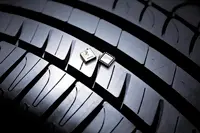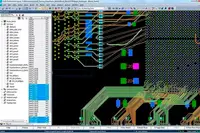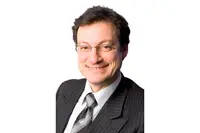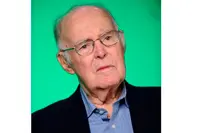Electronics News
Archive : 28 April 2015 год
 Freescale has added the wireless FXTH8715 family to its tyre pressure monitoring system (TPMS) portfolio. The device is said to come in the industry's smallest fully integrated package and to provide the highest pressure accuracy for trucks and other large vehicles.
Freescale has added the wireless FXTH8715 family to its tyre pressure monitoring system (TPMS) portfolio. The device is said to come in the industry's smallest fully integrated package and to provide the highest pressure accuracy for trucks and other large vehicles.
The system integrates a dual axis accelerometer, motion sensor, a 315/434 MHz RF transmitter, a 125kHz receiver, pressure and temperature sensor and an 8bit MCU in a 7 x 7mm package. Onboard intelligence is said to enable the collection and transmission of sensor data, including pressure, temperature and acceleration. Using this data, fleet owners can use analytics to improve maintenance.
Pressure accuracy is said to be ±17kPa while the device can measure pressures in the range from 100 to 1500kPa (215 psi).
"Highly accurate tyre pressure sensing solutions capable of communicating wirelessly offer tremendous advantages in terms of driver safety, fuel efficiency, reliability, tyre wear and advance warning prognostication for trucks and heavy vehicles," said Babak Taheri, general manager of Freescale's Sensor Solutions Division. "The FXTH8715 family takes tyre pressure monitoring to new levels by capturing and transmitting valuable sensor data that helps fleet managers not only monitor tyre pressure, but also track driving behaviour and optimise predictive maintenance."
Author
Graham Pitcher
Source: www.newelectronics.co.uk
 In a move which it claims will redefine the market for PCB Design software, Mentor Graphics has introduced three new packages to its PADS product line.
In a move which it claims will redefine the market for PCB Design software, Mentor Graphics has introduced three new packages to its PADS product line.
Jamie Metcalfe, market development manager, said the market had historically been seen as a pyramid. "We want to address the market from a company size point of view. While larger companies typically use Enterprise solutions, smaller companies still have a need for these products, but don't always have the budget. We're addressing a segment of the market that's been left behind."
Mentor says the new market is typified by what it calls 'independent engineers'. "These are inviduals or small workgroups who operate locally," Metcalfe explained. "And they tend to be generalists, rather than specialists, so are involved in many aspects of PCB design."
Looking to meet the needs of independent engineers, Mentor has launched PADS Standard, PADS Standard Plus and PADS Professional. The packages cost $5000, $10,000 and $18,000 respectively and each comes with support for one year.
PADS Standard offers schematic and PCB layout with a starter parts library, a part creation wizard and archive management. Standard Plus adds advanced constraint management, HyperLynx powered signal, thermal and analogue simulation, and variants design. Professional, meanwhile, brings what Metcalfe called 'Xpedition level features' such as sketch routing, simultaneous 2D/3D layout and hierarchical placement planning.
Users of all three packages can access more than 360,000 parts via the PartQuest website that merges Digi-Key part numbers with symbols and footprints.
Author
Graham Pitcher
Source: www.newelectronics.co.uk
A team led by UCL has used 3D imaging techniques to determine what happens inside a lithium-ion battery when it overheats and then explodes. According to the researchers, it is important to understand how Li-ion batteries fail in order to improve their design to make them safer to use and transport. Recently, three airlines announced they will no longer carry bulk shipments of lithium-ion batteries after the US Federal Aviation Administration found overheating batteries could cause major fires.
UCL PhD student Donal Finegan said: "We combined high energy synchrotron X-rays and thermal imaging to map changes to the internal structure and external temperature of two types of Li-ion battery as we exposed them to extreme levels of heat. We needed exceptionally high speed imaging to capture 'thermal runaway' – where the battery overheats and can ignite.
"This was achieved at the European Synchrotron Radiation Facility's beamline ID15A, where 3D images can be captured in fractions of a second thanks to the very high photon flux and high speed imaging detector."
The team looked at the effects of gas pockets forming, venting and increasing temperatures on the layers inside two distinct commercial Li-ion batteries as the battery shells were exposed to temperatures in excess of 250°C.
The battery with an internal support remained largely intact until the initiation of thermal runaway, at which point the copper material inside the cell melted indicating temperatures up to 1000°C.
In contrast, the battery without an internal support exploded, causing the entire cap of the battery to detach and its contents to eject. Prior to thermal runaway, the tightly packed core collapsed, increasing the risk of severe internal short circuits and damage to neighbouring objects.
UCL's Dr Paul Shearing noted: "Although we only studied two commercial batteries, our results show how useful our method is in tracking battery damage in 3D and in real-time. The destruction we saw is very unlikely to happen under normal conditions as we pushed the batteries a long way to make them fail by exposing them to conditions well outside the recommended safe operating window. This was crucial for us to better understand how battery failure initiates and spreads. Hopefully from using our method, the design of safety features of batteries can be evaluated and improved."
The team now plan to study what happens with a larger sample size of batteries and, in particular, what changes at a microscopic level cause widespread battery failure.
Joining UCL in the work was the European Synchrotron Radiation Facility, Imperial College London and the National Physical Laboratory.
Author
Graham Pitcher
Source: www.newelectronics.co.uk
 Avnet Electronics Marketing EMEA says it has decided to enhance its operations by combining the sales forces of Avnet Memec and Silica into one with effect from 29 June 2015.
Avnet Electronics Marketing EMEA says it has decided to enhance its operations by combining the sales forces of Avnet Memec and Silica into one with effect from 29 June 2015.
The combined organisation will be led by Mario Orlandi, pictured, currently president of Silica. "This is an opportunity to extend our offerings and our customer base at the same time. As we operate in a competitive market environment, where speed of execution and expertise are king, we leverage the growth scalability of a bigger sales force while keeping the technical focus of specialist distribution."
The move is said to be a logical progression as both companies already share back end facilities. The two already share a sales force in Austria, Switzerland and Iberia and the move extends this to the EMEA region. However, demand creation activities, technical marketing and application support will remain separate.
Miguel Fernandez, president of Avnet EM EMEA, added: "Making Silica and Avnet Memec one company across Europe with two distinctive demand creation forces will help us drive scale and focus for many exclusive manufacturer relationships."
Author
Graham Pitcher
Source: www.newelectronics.co.uk
 The Electronic Components Supply Network (ECSN) has reported what it calls 'a welcome improvement' in total monthly billings in March 2015. Consolidated figures reported by the association's authorised distributor (AFDEC) membership show that billings increased by 10% compared to February and by 2% over March 2014.
The Electronic Components Supply Network (ECSN) has reported what it calls 'a welcome improvement' in total monthly billings in March 2015. Consolidated figures reported by the association's authorised distributor (AFDEC) membership show that billings increased by 10% compared to February and by 2% over March 2014.
ECSN chairman Adam Fletcher said it is likely the improvement in sales will be reflected in its Q1 2015 figures. "Early and, as yet, unaudited figures for Q1 2015 indicate that billings increased by 9% in Q1 when compared to the previous quarter and by 1.4% when compared to Q1 2014. These figures are towards the upper quartile of our members' growth forecast for Q1 2015."
However, the book to bill ratio grew by 2% over February, there was a 5% decline compared to March 2014. "The polynomial trend continues to indicate that the book to bill will remain positive into the second half of 2015," Fletcher added.
According to Fletcher, ECSN members believe 2015 is likely to see low consolidated growth, reflecting the economic environment.
Author
Graham Pitcher
Source: www.newelectronics.co.uk
 One thing Gordon Moore wasn't thinking about when he contributed an article to the 35th anniversary issue of Electronics magazine was creating a law of any kind.
One thing Gordon Moore wasn't thinking about when he contributed an article to the 35th anniversary issue of Electronics magazine was creating a law of any kind.
But his prediction – because that's what it was – has indeed turned into a law and a law which has driven the semiconductor industry to its current levels of excellence.
What has now become known as Moore's Law started with an observation by Moore – who was still with Fairchild at the time – that the number of transistors per unit area of silicon was doubling on a regular basis and that the progression was likely to continue.
What he actually said was 'the complexity for minimum component costs has increased at a rate of roughly a factor of two per year. Certainly, over the short term, this rate can be expected to continue, if not to increase. Over the longer term, the rate of increase is a bit more uncertain, although there is no reason to believe it will not remain nearly constant for at least 10 years'.
A decade later, with the industry still following the prediction closely, Carver Mead, a professor at Caltech, dubbed the observation Moore's Law.
Although the industry hasn't adhered to Moore's Law exactly since then, it still uses the concept as its engine of progress.
One interpretation of Moore's Law is the number of transistors per unit area. Another is the cost of making those transistors; Moore himself recognised that process shrinks, as they have come to be known, were going to bring significant cost benefits to the industry. Now, if a leading company isn't making chips on the lastest process, it isn't making them as cost effectively as it could.
What is amazing about Moore's Law is the complexity – or lack of it – of integrated circuits at the time. Moore noted at the 40th anniversary of the article's publication: "The most complex IC we had then had just 30 components. And we had one with 60 components that would be introduced in the next year."
Here's an interesting contrast. The 4004 microprocessor, launched by Intel in 1971, contained 2300 transistors. Today, the 5th Generation Intel Core processor features 1.3billion. And, according to Intel, more than 6million of its latest Tri-Gate transistors can fit on a full stop.
The question now is how long Moore's Law can continue to be applied by the industry as silicon begins to encounter the laws of physics. Moore himself has reservations. Speaking a couple of years ago, he expected industry progress to continue 'for a decade or so'.
One of the major roadblocks has recently been overcome with the development by Intel and others of the FinFET approach. Because linear scaling is becoming increasingly difficult, the gates of the transistor have been turned on their side to allow more devices to be fitted into a given area. This is allowing technologists to address nodes smaller than the 14nm and 16nm processes beginning to enter production.
Being able to squeeze twice as many transistors into a given area of silicon on a regular basis becomes increasingly difficult. Feature sizes are now some ten times smaller than the wavelength of light being used to create them and this is pushing technology to the limits.
The challenge for the industry now is to move from immersion lithography at 193nm to extreme ultraviolet lithography: a move which has taken significantly longer than expected.
Talking to Intel earlier in 2015 about his Law, Moore said: "The industry has been phenomenally creative in continuing to increase the complexity of chips. It's hard to believe – at least it's hard for me to believe – that now we talk in terms of billions of transistors on a chip rather than tens, hundreds or thousands."
Author
Graham Pitcher
Source: www.newelectronics.co.uk

